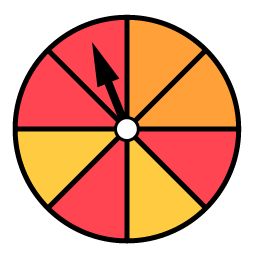D2.1 Use fractions to express the probability of events happening, represent this probability on a probability line, and use it to make predictions and informed decisions.
Activity 1: Using Fractions to Express Probability
Show students the spinner below divided into eight different coloured parts.

Represent, as fractions, the probability that the arrow will stop on:
- orange (since the orange colour occupies a quarter of the circle, the probability that the arrow will stop on this colour is \(\frac{2}{8}\), or \(\frac{1}{4}\);
- red (since the colour red occupies half of the circle, the probability that the arrow stops on this colour is \(\frac{4}{8}\), or \(\frac{1}{2}\);
- yellow (since the colour yellow occupies one quarter of the circle, the probability that the arrow will stop on this colour is \(\frac{2}{8}\), or \(\frac{1}{4}\).
Activity 2: Representing a Probability on a Probability Line
Put the values below on the probability line.
\( 0 \ \ \frac{6}{8} \ \ \frac{1}{4} \ \ \frac{4}{8} \ \ \frac{9}{12} \)

Activity 3: Making Predictions Using Probability
Present students with the following situation:
Frederique plays basketball. She makes an average of 5 out of 10 baskets. She makes 4 consecutive attempts. How many baskets do you think she will make? Explain your prediction with a probability.
